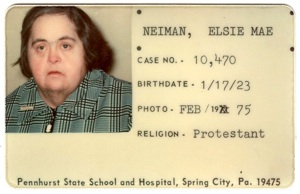the pennhurst project blog

Dolly’s story
Tuesday, April 27, 2010

Elsie Mae “Dolly” Neiman was my great-aunt. She was born at home on January 17, 1923 when my great-grandmother Mary (Cauler) Neiman was already in her mid-late forties, circumstances that increase the risk of Down syndrome. According to her siblings, Dolly was slow to learn to walk and talk and at the age of four, she was taken by her parents to Philadelphia for a psychological examination. The results were unsettling: "mongoloidism" and “retardation…confirmed by examiner and test results.”
Again at age 13, Dolly was taken for a psychological examination, this time to Pennhurst, but she was not admitted at this time, even though a captain in the Salvation Army unit that Mary was active in had "strongly recommended" that Dolly be placed in an institution. Much to her credit, my great-grandmother chose to keep Dolly at home and continued to care for her after her second husband Luther Neiman died in 1954. When Mary herself died in 1961, Dolly was taken in by her sister Laura and brother-in-law J. Russell Eckenrode.
By 1966, Russell, 65, could no longer care for Dolly at home after his wife’s broken leg and diagnosis of osteomyelitis rendered her a semi-invalid. His decision to place Dolly in Pennhurst, however, did not come lightly. He wrote that he was “quite concerned and somewhat uneasy” about sending her to Pennhurst, an institution where “he had always heard so many stories and rumors.” But Dolly’s only income was social security disability and that wasn’t nearly enough to pay for a more expensive nursing home. Pennhurst was the only solution.
Dolly was placed on the waiting list on January 3, 1967. On January 31, 1975 she was admitted at age 52 to Unit 6, M-2 Cottage, as patient number 10,470 on the Pennhurst rolls. She was released to a Community Living Arrangement (CLA) in 1982.
The aides wrote that Dolly had a tendency to “holler and curse” when she was upset (well, that certainly runs in the family!). They said she loved music and had a good sense of humor. One of the nurses on duty at the Clifford Nursing Home where Dolly stayed before being admitted to Pennhurst, E. Byerly, R.N., wrote in 1974 that Dolly “talks and curses in a cute way” and that her “language would shock anyone.” Another psychological evaluation in 1975 by Staff Psychologist Anne Brown of the MH/MR Services of Chester County noted that Dolly tested at an IQ of 20 and had a mental age of three years, five months and a social age of four years, ten months. Brown wrote: “Since her time and space orientation, comprehension and judgment are severely limited, an institutional placement such as Pennhurst State School and Hospital is highly recommendable."
Aides wrote that Dolly was sweet and likable and even-tempered, although she did have her quirks, like always referring to herself in the third person singular. Psychiatrist M. R. Demmy described Dolly’s unique replies to his questions: “[I]n answer to the examiner’s question, ‘are you happy?’ she responded: ‘She’s nice—she’s nice and cool, Dolly was. She just got out of the bathtub…" She went on to make some pretty astute observations about her confinement at Pennhurst: "She doesn’t like to be put away…Phyllis wants to put her away in a ‘dumb house’…That’s what Phyllis told her.’”
Imagine having the mind of a small child in an adult body. Then imagine what it must have been like for Dolly, at age 52, to suddenly see all the frightening images of the Pennhurst wards, the rocking, head-banging, self-stimulation and nakedness of it all, the smells and the chaos, all through the eyes of a child who had always before been loved and sheltered in her family’s home. Well, I guess I’d “holler and curse,” too.

